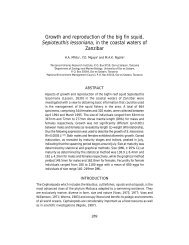gpa_east_africa_case.. - GRID Africa GeoPortal - UNEP
gpa_east_africa_case.. - GRID Africa GeoPortal - UNEP
gpa_east_africa_case.. - GRID Africa GeoPortal - UNEP
You also want an ePaper? Increase the reach of your titles
YUMPU automatically turns print PDFs into web optimized ePapers that Google loves.
Mauritius 33 41 42Seychelles 25 54 59Source: Human Development Report, 1997Country Economic IndicatorsThe national economy for Tanzania has been growing at 3.1% per year since 1987 thatgreatly exceeded the average annual rate of the previous 5 years that had reached 1% peryear. The private sector accounts for 80% of internal trade, of which 70% involves domesticproduction. Yet, growth in the agriculture sector, which remains the larger potential employer,fell from 19% of GDP in 1995 to 13.5% in 1996. The economy of the country is dependant onagriculture; approximately 90 % of the population is engaged, directly or indirectly, inagricultural activities which produce 60% of GDP and more than 75% of the foreign exchangeearnings. Other important economic sectors include fisheries, mining, wildlife, forestry, andtourism. Zanzibar, a rather closed economy in the past, has recently opened up to tradefollowing the adoption of the free trade policy in the mid-1980s. This has attracted manyinvestors most notably in the tourism sector. Following these developments, Zanzibar haswitnessed significant social and economic changes. New industries have flourished alongmost of the <strong>east</strong>ern coastal area.The economy of Kenya is dependent mainly on agriculture, tourism and industry. These threesectors contribute over 85% to the GDP, about 20%, 45% and 20% respectively. Fisheriesand mining account for less than 1%. The national economy of Kenya has been growing at1.8 % per year since 1988, with the inflation rate at 6.6 %.Prior to independence in 1976, the Seychelles was primarily a subsistence agriculturalfishingeconomy with limited cash crop exports. During the 1970s and 1980s tourism wasestablished as a major economic sector, followed by manufacturing and fishing activities,while agriculture has steadily declined in importance. Fisheries and manufacturing havecontinued to be the focus of economic activities during the 1990s. While tourism is today thefastest growing sector in the Seychelles economy, in 1995 tourism and food-related industrywere estimated to generate roughly the same share of GDP, about 20%. Tourism earns over60% of foreign exchange, compared to 10% of fisheries that produced some 90% of domesticexports of goods.Mozambique is one of the eight poorest countries in the world. The country’s debt wasaround 1 billion US $ in 1990 that grew to about 5 billion US $ in 1996. To reverse economicdecline, the Mozambique government, in the context of the 1987 Structural AdjustmentProgramme aimed to reduce state control of the economy and promote the family sector as avital component of the private sector-led development process in agriculture production andmarketing. These and other economic reforms have contributed positive results withconsequent GDP growth of about 1% in 1986 reaching 2% in 1990. The main economicsectors in Mozambique are agriculture and fisheries each contributing about 40 % of the totalexport earning in 1995 (<strong>UNEP</strong> TDA/SAPWOI, Maputo, 1998).Coastal PollutionCoastal pollution in the region originates predominantly from land-based sources mainlyassociated with urban and industrial uses. Major pollution sources are connected to urbanindustrial and municipal activities in areas where such used are concentrated. According to<strong>UNEP</strong>/IMS, UDSM/FAO/SIDA, (1998), the pollution issues of greatest concern include:• Microbial contamination of groundwater resources from uncontrolled on-site disposalpractices or degenerated sewerage infrastructures. The majority of the population in theregion in Kenya, Tanzania and Mozambique use septic tanks and pit latrines. Accordingto Mwaguni and Munga, (1997), analyses of water samples from wells and boreholesindicate widespread microbial contamination (total and feacal coliform) of groundwater inMombasa; only 3 of the 23 wells sampled passed drinking water standards. Studies in theMaputo Bay have revealed that feacal coliforms, feacal streptococci and escherichia coliwere detected in marine water and shellfish tissues. (Fernandes and Hauengue, 1997).Final Draft Report – Cost Benefit Case StudiesGPA Strategic Action Plan on Sewage, October, 200065



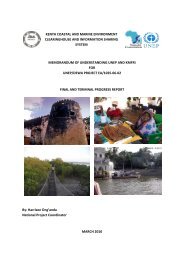
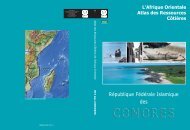
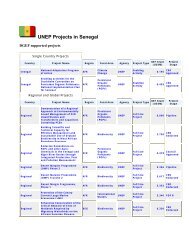

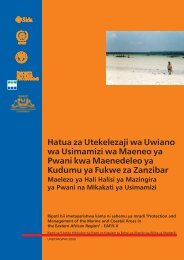
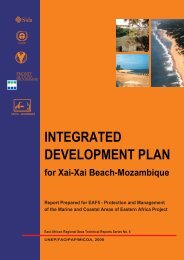
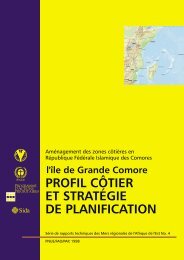
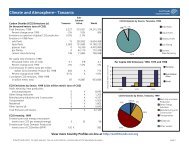

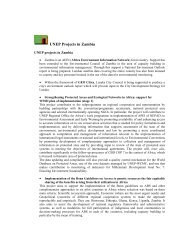
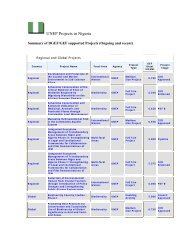
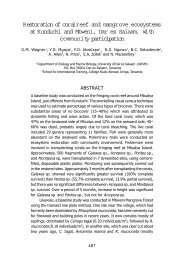
![Please Click to download [English] - GRID Africa GeoPortal - UNEP](https://img.yumpu.com/30633391/1/184x260/please-click-to-download-english-grid-africa-geoportal-unep.jpg?quality=85)
